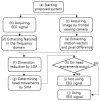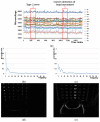Noise reduction in brainwaves by using both EEG signals and frontal viewing camera images
- PMID: 23669713
- PMCID: PMC3690055
- DOI: 10.3390/s130506272
Noise reduction in brainwaves by using both EEG signals and frontal viewing camera images
Abstract
Electroencephalogram (EEG)-based brain-computer interfaces (BCIs) have been used in various applications, including human-computer interfaces, diagnosis of brain diseases, and measurement of cognitive status. However, EEG signals can be contaminated with noise caused by user's head movements. Therefore, we propose a new method that combines an EEG acquisition device and a frontal viewing camera to isolate and exclude the sections of EEG data containing these noises. This method is novel in the following three ways. First, we compare the accuracies of detecting head movements based on the features of EEG signals in the frequency and time domains and on the motion features of images captured by the frontal viewing camera. Second, the features of EEG signals in the frequency domain and the motion features captured by the frontal viewing camera are selected as optimal ones. The dimension reduction of the features and feature selection are performed using linear discriminant analysis. Third, the combined features are used as inputs to support vector machine (SVM), which improves the accuracy in detecting head movements. The experimental results show that the proposed method can detect head movements with an average error rate of approximately 3.22%, which is smaller than that of other methods.
Figures














References
-
- Yuen C.T., San W.S., Rizon M., Seong T.C. Classification of human emotions from EEG signals using statistical features and neural network. Int. J. Integr. Eng. 2009;1:71–79.
-
- Rebsamen B., Guan C., Zhang H., Wang C., Teo C., Ang M.H., Burdet E. A brain controlled wheelchair to navigate in familiar environments. IEEE Trans. Neural Sys. Rehab. Eng. 2010;18:590–598. - PubMed
-
- Zhang B., Wang J., Fuhlbrigge T. A Review of the Commercial Brain-Computer Interface Technology from Perspective of Industrial Robotics. Proceedings of the 2010 IEEE International Conference on Automation and Logistics; Hong Kong and Macau. 16–20 August 2010; pp. 379–384.
-
- Bang J.W., Lee E.C., Park K.R. New computer interface combining gaze tracking and brainwave measurements. IEEE Trans. Consum. Electron. 2011;57:1646–1651.
-
- Campbell A.T., Choudhury T., Hu S., Lu H., Mukerjee M.K., Rabbi M., Raizada R.D. NeuroPhone: Brain-Mobile Phone Interface Using a Wireless EEG Headset. Proceedings of the 2nd ACM SIGCOMM Workshop on Networking, Systems and Applications on Mobile Handhelds; New Delhi, India. 30 August 2010; pp. 3–8.
Publication types
MeSH terms
LinkOut - more resources
Full Text Sources
Other Literature Sources

